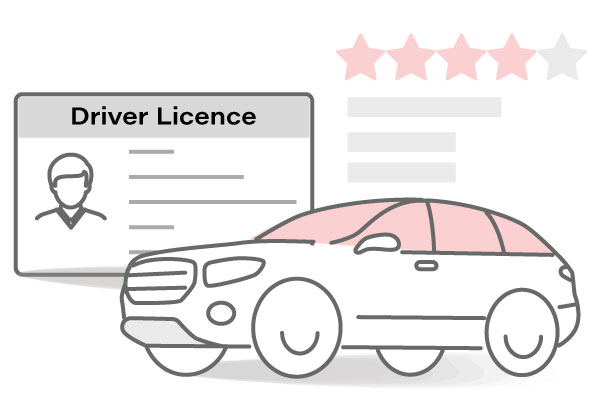
Written by Kayla Jane Barrie Updated on Dec 11, 2025 9 mins read

If you have a driver’s licence, you have a driving record in Ontario. From day one until you retire from driving, your driving record is with you. However, many drivers have no idea what their driving record looks like and what it entails.
An Ontario driver’s abstract is an important document that outlines your driving history. Knowing what is on your driver’s abstract when shopping for car insurance helps you understand how insurers assess how much you will pay.
This blog post outlines everything you need to know about driver’s abstracts in Ontario. Learn how to get a copy of your driving record, the type of records available, the costs and when you need it. Also, get information about CVOR driver’s abstracts for commercial drivers.
Your driving record is pretty self-explanatory. It is a record of you as a licensed driver in the province of Ontario. Whether you have a G1, G2, or G driver’s licence, there is a record of your driving history. This includes tickets, the type of driver’s licence you have, demerit points, and a record of accidents and convictions.
A driver’s abstract is a record of your driving history. It is one of many driving record types you can get through the Ontario Ministry of Transportation (MTO). When referring to a driver’s abstract, most people mean the 3-year uncertified driver’s record. Your driver’s licence abstract is a record of your driving history over the past three years.
There are also several types of driving records. They include your licence history, 5 years and extended driver record.
It’s common for people to use the terms driving record and driver abstract interchangeably. Your Ontario driver abstract is one of the many types of driving records. Your driving record can refer to any of the types of records available.
You are NOT the only one who can access your driving record in Ontario. According to the Information and Privacy Commissioner of Ontario:
"Your record of the past three years is available upon request (with the payment of a fee). Organizations and members of the public request this information from the Driver Licence Database regularly. However, your address is not provided to members of the public who request your driver information."
It can be accessed by:
Many Ontario drivers don’t realize that there are a series of types of driving records. Each one serves a specific purpose and contains different information. Service Ontario lists the types you can request:
There are several different ways you can access your Ontario driver’s abstract. Here are the steps to order a driver’s abstract:
Yes. You can get access to your driver’s abstract online through Service Ontario. You will need your driver’s licence number. You’ll receive the certified driver's abstract in the mail. Use a device that has Adobe Reader to view your uncertified driver’s abstract online.
If you are looking to get a copy of your driver’s licence abstract, you can do so by:
Many drivers are curious about what shows up on a driver’s abstract. The following information appears on all Ontario driver’s abstracts:
Your driver’s abstract provides details for the previous three years. Extended driver’s abstracts can show your driving information for the previous five years. The information on driver’s abstracts can vary from province to province.
There are some situations where you will receive a driver's abstract request. You may need a driver’s abstract when:
An Ontario driver’s abstract costs $12. You can get a certified driver’s abstract for $18 through Service Ontario. The cost for a complete driver's record is $48 (uncertified) and $54 (certified).
The Commercial Vehicle Operator’s Registration Abstract, or CVOR abstract, is a document for commercial purposes. It shows information about a carrier, safety performance, and driver for a driving event. It provides information about:
These abstracts are for commercial auto insurance purposes. All carriers must have a valid CVOR certificate in each truck or vehicle they operate. This includes tow trucks and buses.
There are three types of CVOR abstracts:
Having a good driving record in Ontario is essential for many reasons. It can impact your insurance costs and your ability to get a job. There are negative repercussions for having a bad driving record.
A clean driving record means you have no tickets, driving infractions, or accidents. All drivers start with a clean driving record, and having one can mean lower Ontario car insurance.
You can obtain a copy of your driving record. If you have never gotten a ticket or been in an accident, you likely have a clean driving record.
Do you have a couple of tickets or have you been in an accident recently? Understandably, you want to clear your driving record. Most driving infractions stay on your driving record for 3 years. At-fault accidents can stay on your record for up to 10 years.
In most instances, the only way to clean your driving record is time. Drive accident and ticket-free and wait for the time to expire. Make sure to follow up and check to ensure it’s accurate.
There are three main things that will impact your driving record:
We all know a bad driving record and insurance don’t mix. There are other aspects of your life it can affect. They include :
Many young drivers incorrectly assume they get a clean slate when they turn 25. Your driving record does not start over when you turn 25. The age of 25 is a sign that you may pay less for insurance. But it has no bearing on your driving record.
If you have a ticket on your record, it is still there when you turn 25. You will still have to wait for three years before removing it.
There is no doubt a bad driving record will impact your insurance. It can impact your insurability in several ways:
No. You are not the only one that can access your driver’s abstract in Ontario. Insurers and the police also have access. Anyone can access this record if they have access to your driver’s licence number.
It depends on the insurer. Many will check your driving record at car insurance renewal time to ensure there are no new tickets or accidents. They could check it any time.
Insurers have different policies about how far back they check driving records. Most will look back 3 years for tickets and 6 years for accidents. Some insurers may look up to 10 years back for accidents.
They can access your driving record through Service Ontario. They can also check the AutoPlus database to check policy and claims information.
No. You have to pay a fee to access your driver's record. The cost can vary based on the type of driving record. Service Ontario provides a list of all available abstracts and costs.
There is one main difference between uncertified and certified driver abstracts. The certified version shows the embossed seal from the Ministry of Transportation. The uncertified version does not.
A clean driver abstract means you have a clean record. You do not have any tickets or accidents within the last 3 years.
Your driver abstract is a snapshot of your driving history. It will list your identification details, demerit points, convictions, and active fine suspensions. This information will change over time. It will go back three years from the date you request it.
A perfect driving record is one with no tickets or traffic accidents. It’s also referred to as a clean driving record. A perfect driving record will help you save money on insurance.
It could. An at-fault accident could stay on your record for at least 6 years. Depending on your insurer, this could increase your premiums.
Yes. All traffic tickets and violations will appear on your driving record. They will stay on your record for 3 years.
Learn more about how your driver’s abstract can impact your Ontario car insurance by talking with a ThinkInsure advisor.
| Categories | Industry NewsAuto |
|---|---|
| Tags | Auto CoverageFAQsDriving TipsLicence |
Read our insurance blog to get helpful tips, information and news.
Has your car been totalled in an accident? Is your car a write off? Learn about vehicle write offs for a total loss insurance claim.
Get the facts on Toronto's auto theft problem. We break down the data, reveal the most-stolen vehicles (including the Honda CR-V and Lexus RX 350), and show which neighbourhoods are most affected.
Dive into the world of auto theft with our blog on the most stolen cars in Canada. See the most stolen cars across Canada, including provincial lists for Ontario and Quebec, and learn how high-risk models can affect your car insurance premiums.
Drive safe this winter! Check out these tips for driving in snowy and icy conditions in Ontario. Get other helpful info and FAQs on winter driving.